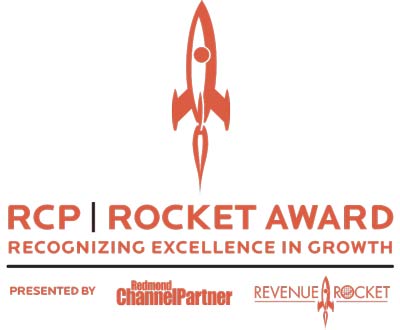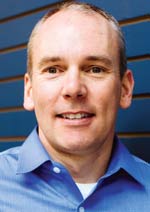In-Depth
2014 RCP Rocket Award Winners: Profiles in Business Courage
Three companies earned our second annual award for sustainable business growth, the RCP Rocket Award. For PowerObjects, HMB Inc. and Concurrency Inc., common business problems were the cauldron from which stronger companies emerged.
- By Scott Bekker
- October 07, 2014
Sometimes trouble can be the catalyst for tremendous and sustained business growth.
A serious blow can knock a company out of a comfortable rhythm. In many cases that blow will be fatal to the company. On occasion, though, it's the opportunity to rethink the assumptions underlying a business, a chance to start fresh, a chance to launch version 2.0.
The winners of the 2014 RCP Rocket Awards all fall into that category of business reinvented. The decline of a key vendor, the retirement of a partner, the loss of a customer -- it was a different problem in each case, but the responses were similar.
PowerObjects, HMB Inc. and Concurrency Inc. all rallied, putting in the strategic thought and the hard work required to recover from trouble and come back stronger.
This is the second year for the RCP Rocket Awards honoring excellence in growth. The awards are a joint project of Redmond Channel Partner magazine and Minneapolis-based Revenue Rocket Consulting Group, an IT services growth consultancy run by longtime RCP columnist Mike Harvath. The award was open to U.S. IT services companies with revenues between $5 million and $75 million a year and a record of sustained growth over the last three years.
"All three winners of the RCP Rocket Award are a testament to resolve in the face of adversity. In order to grow, the companies chose to focus on a select mix of Microsoft technologies and vertical markets, supported by an unwavering commitment to the execution of their growth strategies," says Mike Harvath, CEO of Revenue Rocket, and one of the judges. "The path was different for all three, but the results were the same; sector-leading growth in revenue and profit resulting in all three becoming undisputed leaders in their respective fields."
Each company's story is told in profiles over the next few pages (along with a brief note from Harvath about why each won). Congratulations to the 2014 RCP Rocket Award winners!

PowerObjects Sets a BHAG
For a 25-person company in Minneapolis to set a goal to be named by Microsoft as the No. 1 Dynamics CRM partner in the world seems overly ambitious.
That's what the leadership team of PowerObjects intended when they made it their Big Hairy Audacious Goal (BHAG) in 2008. BHAG is a concept borrowed from "Built to Last: Successful Habits of Visionary Companies," a 1994 business book by James Collins and Jerry Porras.
"At that time, it looked a lot farther away than it ended up being," says Jim Sheehan, COO and partner at PowerObjects.
Fast forward a few years and PowerObjects is up to 230 employees, has booked revenue growth of 107 percent in 2011, 47 percent in 2012 and 46 percent in 2013 and enjoyed profitability through the entire period. As for those awards, PowerObjects won Microsoft's top prize worldwide for Dynamics CRM partners in both 2012 and 2013. (The company was also a finalist for the award this year.) Meanwhile, it's also rolling up the year on a pace to finish with more than $25 million in revenue and a strong possibility for 100 percent year-over-year growth again.
 "One of the ultimate goals last year was to publish the world's most authoritative guide to Dynamics CRM. ... For the company, it helps us positively impact people."
"One of the ultimate goals last year was to publish the world's most authoritative guide to Dynamics CRM. ... For the company, it helps us positively impact people."
Jim Sheehan, COO and Partner, PowerObjects
Sheehan says setting that BHAG was critical. "That's what really helped us create our focus. It's like the flag in golf. You know when you're going toward it."
The PowerObjects leaders made sure everyone at the company knew the focus, which was important because the company was in transition. Founded in 1993 by Dean Jones, the company spent a strong first decade as a staff augmentation/custom application development shop with an emphasis on Sybase tools. Opportunities started to wane with the dotcom bust, and the subsequent consolidation of IT services companies. At the same time, innovation was dwindling on the Sybase toolset.
Knowing they needed to do something, the leadership team brought in an implementer to help the company get on the business writer Gino Wickman's Entrepreneurial Operating System (EOS), says Sheehan. During the process, they also focused on the "Built to Last" concept of the BHAG. Nearly every decision by every employee at every level of the company needed to take the new goal into account. It became part of employees' departmental scorecards.
"It was the litmus test that's out there in the distance. Initially, if it wasn't going to allow us to be the No. 1 Dynamics provider in the world, we weren't going to do it," Sheehan says. "It makes business questions very easy to answer."
The goal influenced geographic decisions, as well. Expansion opportunities in a few geographies being roughly equal, PowerObjects chose to open its first office outside of Minneapolis in Dallas to bring the company closer to Microsoft Central Region leadership for better alignment with Microsoft and to establish a presence in the South Central District to match their existing coverage in the North Central District. "We first needed to establish our dominance in the Central Region," Sheehan explains.
Since then the company also opened offices in Chicago, Cincinnati, Omaha, New York, Philadelphia, Atlanta and Seattle. You can see the logic in the PowerObjects expansion by visualizing the company growing first in the Central Region, subsequently moving to create a similarly large presence in the East Region and taking the opportunity to have some resources close to Microsoft's global headquarters in Redmond for further alignment and visibility.
Achieving the BHAG already in 2012 was even surprising internally. "Whoops!" jokes Sheehan. "We had to step back. Did this mean we're done? We knew we weren't. Are we still trying to become the largest Dynamics CRM partner in the world? We are."
At the end of 2012, PowerObjects set a new BHAG -- to add value to 1 million people for Dynamics CRM.
While seats are important, that's not all PowerObjects is measuring with the metric. "It's people using our blog for education. It's customers that we've sold or implemented to. A lot of it has to do with Web site traffic," Sheehan says.
One way PowerObjects generates Web traffic is with "The CRM Book." "One of the ultimate goals last year was to publish the world's most authoritative guide to Dynamics CRM. With the software changing so fast, we thought we can't do a printed book, we're going to have to do a cloud-based book. For the company, it helps us positively impact people," he explains.
Sheehan estimates that at the time PowerObjects set that goal it was 10 percent of the way to adding value for 1 million users. Now, he believes the company is 20 percent of the way to the goal. If history is any guide, PowerObjects management should probably be thinking already about BHAG No. 3.
HMB and the $149 Squeeze Ball
A debate over a squeeze ball, those promotional toys that end up in the junk drawer of every tradeshow and job fair attendee ever, gave HMB Inc. the bounce it needed.
CEO Tom Harris sets the scene as a run-of-the-mill 2008 meeting of key employees of the Columbus, Ohio-based business technology services firm with a Microsoft Silver Competency in Application Development.
"One day we were sitting in our operations meeting. The recruiting coordinator came in and wanted to spend $149 for squeeze balls. We debated that $149 purchase for about 45 minutes. Can we get them cheaper? What logo are we going to use?" Harris recalls.
Then came the realization, Harris says: "This is ridiculous, we just spent about $3,000 of company time on a $149 decision."
Knowing that something needed to change didn't occur in a vacuum. The stock market decline had begun and the recession was becoming apparent everywhere. Harris and another co-founder, John Mackessy, were also a little on edge over the retirement of Patrick Brennan, the "B" in HMB.
 "We really started down that restructuring path in 2009 and 2010. ... We didn't want to disrupt the company too much. It's like engine parts. If you put it all together, it runs pretty well."
"We really started down that restructuring path in 2009 and 2010. ... We didn't want to disrupt the company too much. It's like engine parts. If you put it all together, it runs pretty well."
Tom Harris, CEO, HMB Inc.
The retirement was completely amicable, but Harris remembers it was also a wake-up call. "At that time, everything ran through us -- recruiting, sales, account management, accounting. We did everything," he says. What if something happened to one of the two remaining founders? "The answer wasn't very good. It was kind of scary. We didn't purposely not share details. It was how we'd been running the business."
It was a case of a company culture that had been great at one size, but was preventing HMB from finding another gear.
The co-founders started the firm in 1994 out of frustration working elsewhere as developers. "A small percentage of people were compensated very well and were receiving all the rewards for the success of all the people," Harris says of the culture the trio rejected. "We thought, 'We can create a company for consultants run by consultants.' We wanted to reward high performers, but the people in the trenches doing the job, they're the ones who need incentives. When we had success at a customer site, we wanted to reward the people who were there. The sales guy didn't do it all."
In addition to profit sharing, another cultural factor was becoming problematic by 2008. "The other mantra that we had that was very near and dear to us from a culture perspective was that we're all out there working. We don't have a lot of overhead. For the first 16 years, all the people in the firm worked at client sites, including myself and the other founders. No job is not good enough for us. We've always believed in that."
The business grew fast in the 1990s, but the everyone-in-the-trenches attitude probably kept the business from breaking out of the high-30s/low-40s consultant range for most of the 2000s, Harris now believes.
The $149 squeeze ball sparked another conversation within the leadership team that had a much higher return on investment. "We were really good at working in the business and not on the business," Harris says. "A couple of us said, 'We're not going to be billable employees anymore. We're going to work in the headquarters, and we're going to build the business.'"
Part of building the business involved creating structure. "We didn't have job titles for a lot of people, including ourselves. We needed to grow up from a business perspective," Harris says.
The restructuring that followed started with a full-time recruiter and then a second one -- empowered to make squeeze-ball-spending and other decisions. HMB created lines of business with profit and loss responsibility and put leaders in charge of them. In order to support fast growth, HMB formalized a mentoring and training program, called HMB University.
Another important cultural shift was recognizing the value of sales efforts. "The majority of our business prior to 2008 was referrals. Just committing to sales was a big deal for us," Harris says.
Those changes paid off with 13.5 percent revenue growth in 2011, 22 percent growth in 2012, 9 percent growth in 2013 and close to 18 percent growth projected for this year. A company that was stuck at around 40 employees through the 2000s is now at 165 employees, including 38 additions in 2013. The company publicly announced plans to hire 75 more employees in central Ohio over the next few years.
"We really started down that restructuring path in 2009 and 2010. We're still on that road. We're 85 percent there," Harris says. "We didn't want to disrupt the company too much. It's like engine parts. If you put it all together, it runs pretty well. It's been fun to sit back and watch; fun to see their excitement and their ideas get implemented."
Concurrency Wins by Losing the Big Customer
Sometimes for a small business, losing your most important customer is the best thing that can happen to you.
James Savage believes that was critical for the explosive recent growth of Milwaukee-based Concurrency Inc., where he's president. In company meetings throughout 2006, a decent-sized bank client that made up a large portion of the Concurrency revenue was a main agenda item. The title of any discussion about the client on slide decks? "Let's not kill the golden goose," says Savage.
"When we lost that big account in December 2006/January 2007, it was the worst thing that ever happened to us, and it was the best thing that ever happened to us," he says. "From January to June of 2007, I found out what the word insomnia means. We became a company in that six-month period," he says. Savage often likens the process to metallurgy and hardening steel. Or, he says, "We got lean and mean, and we've stayed that way ever since."
Concurrency wasn't a new company at the time. Founded in 1989, Concurrency had made a huge transition once before -- going from a Novell Netware focus to a Microsoft Windows NT focus in 1994.
Concurrency responded to losing the customer by reevaluating what it was doing. The hard look covered all the basics -- technological focus, sales, marketing and recruiting.
 "From January to June of 2007, I found out what the word insomnia means. We became a company in that six-month period. ... We got lean and mean, and we've stayed that way ever since."
"From January to June of 2007, I found out what the word insomnia means. We became a company in that six-month period. ... We got lean and mean, and we've stayed that way ever since."
James Savage, President, Concurrency Inc.
Already focused on Microsoft technology, with a complementary enterprise content management practice, Concurrency went "all in" on Microsoft infrastructure technologies. At the time, Microsoft was pushing the "Core IO Model," and that infrastructure optimization business looked good to Concurrency. "We first embraced infrastructure optimization back in 2007. We've been using it ever since, so, way to go Microsoft," he says.
Concurrency now architects and integrates across five Microsoft enterprise platforms -- SharePoint, System Center, Lync, Exchange and Dynamics CRM. System Center is the largest practice area, as evidenced by the company being named a finalist for the 2014 Microsoft Management and Virtualization Partner of the Year. But the company is doing a lot of what Savage terms "grey-haired consulting" that leverages expertise across the stack to provide business value.
Concurrency brings the sales team into that grey-haired process now, as well. Sales offers clients an opportunity to conduct business and technology roadmaps that provide a holistic view of where an organization is from a technology perspective and where it should go based on its strategic goals.
"The key to garner a strategic account is by roadmapping," Savage says.
The company also invested in its pipeline with an aggressive event-marketing effort. Holding events at the local Microsoft office, Concurrency at first drew five or 10 people. After a few months, Concurrency was regularly filling Microsoft's multipurpose room. In addition to educating potential clients, Microsoft field reps walking by the room noticed the crowds and the partner bringing them in.
Concurrency also spun up its own Concurrency University to train all the new hires to support the new business. Over the last three years, the company has been on a revenue and hiring tear. With 20 employees in 2011, Concurrency is now up to 68. Revenues have also nearly tripled in that span, with growth in 2012 at 46 percent and in 2013 at 35 percent